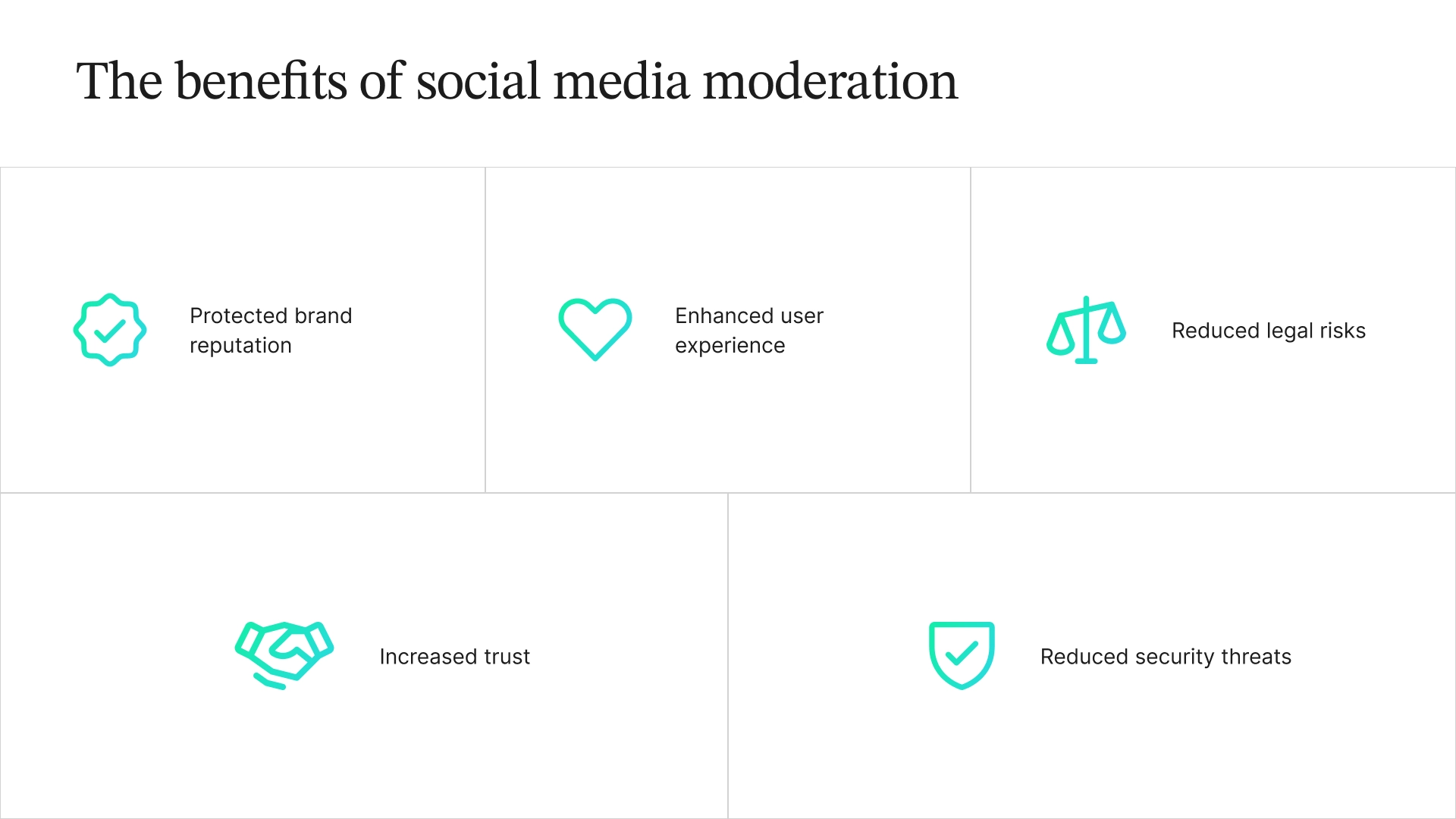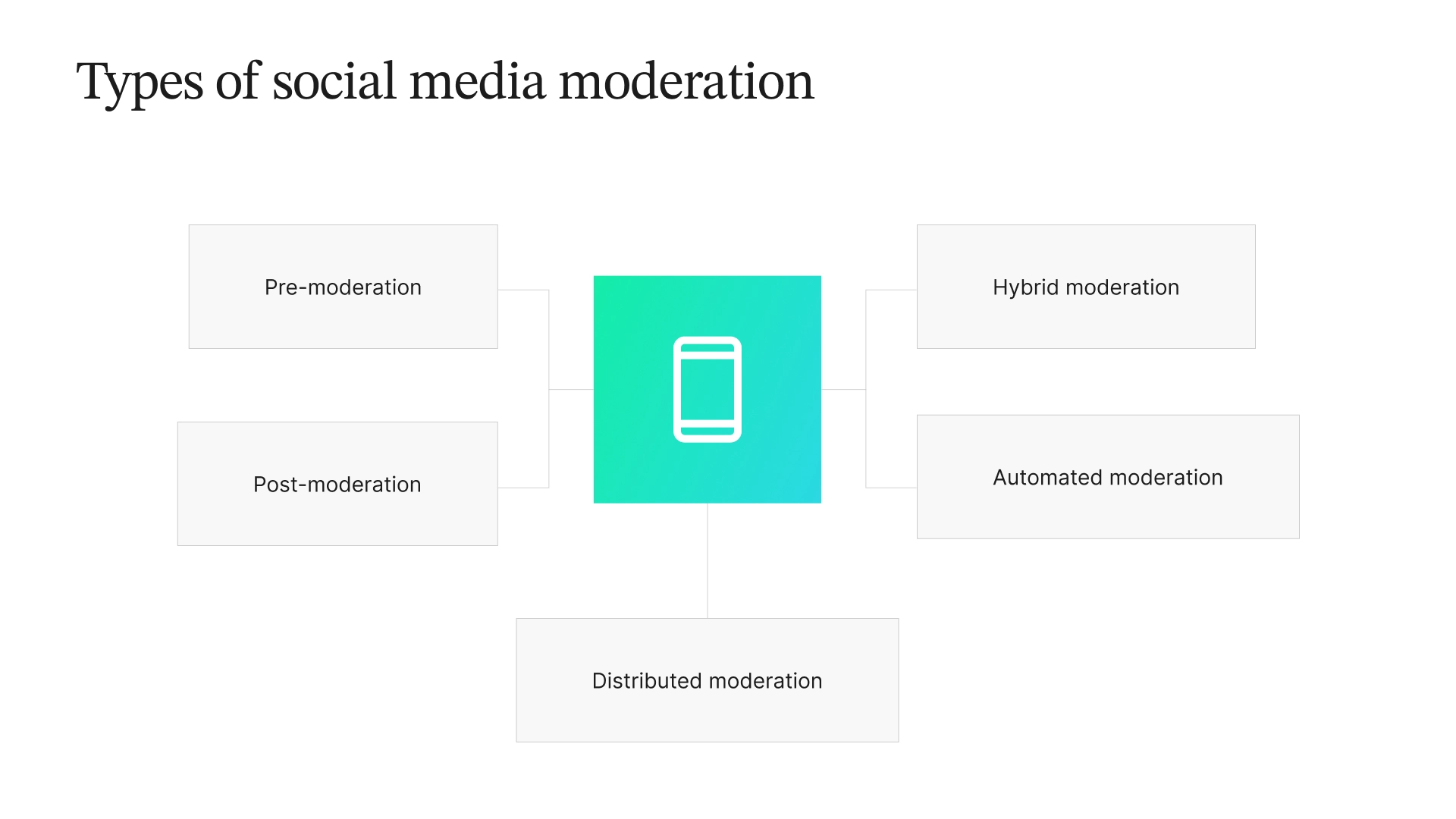We all enjoy social media for opening up our way to online freedom and limitless communication. In a world where every tweet, post, and story can go viral in seconds, social media content moderation has become the linchpin of digital safety. Some social networks are unmoderated and uncensored, while others’ content policies are all about strict guidelines. Where is the fine line between free speech and the chaos of inappropriate content?
With the rising cases of data leaks, illegal content, and unlawful trade of personal information, cybersecurity is still at the forefront of privacy protection, especially in social media. Apps & messengers remain a powerful tool for engagement but are also a hotbed of misinformation, offensive comments, hate speech, and privacy violations. As of March 2024, Meta banned 16 million content pieces containing hate speech. These trends are very worrying and may escalate as social media use continues to rise.
Effective social media content moderation isn’t just about detecting spam or filtering offensive content. Its main goal is to ensure that user-generated content doesn’t turn into a gateway for cyber threats, hate speech, or identity theft while protecting freedom of expression. Given how the number of social media users grew to 5.17 billion in the first half of 2024, investing in their safety and security is a win-win for both businesses and customers.
What is Social Media Content Moderation?
The art of content moderation involves monitoring and controlling the content that is posted on social media. This approach examines how user-generated content is filtered on different platforms to make sure it doesn’t go too far in being offensive or unsuitable for community guidelines or policies. Since users are allowed to post freely, effective moderation is essential.
With the ongoing evolution and complexity of the digital ecosystems, social media content moderation can be intricate too. With billions of people engaging on various platforms, it affects customers’ trust, brand loyalty, and overall company performance. It’s not only a safety precaution. Here’s why companies nowadays should invest in strong social media moderation tactics:

Protected brand reputation
A single remark or post may quickly spoil a trusted brand in the social media sphere. As a first line of defense, social media content moderation is to remove harmful, offensive, or negative information before it gets to the brand’s reputation. Companies can maintain their online profile as professional and trustworthy by using social media moderation methods. It’s important for retention and new customer acquisition.
Enhanced user experience
At its foundation, effective social media engagement is a pleasant user experience. People are more inclined to engage with a company when they see as much content relevance as possible and get value out of that. A social media moderator plays a vital role in maintaining a positive user experience by removing offensive stuff such as spam and hate speech. Customers are more likely to be satisfied, participate more, and become loyal to companies that provide warm and inviting communication.
Reduced legal risks
Social media are under growing pressure from authorities to comply with laws and regulations. Brands rest easy knowing that social media content moderation is in place to keep user-generated material in line with the rules of the platform and any applicable laws. In addition to shielding the company from any legal trouble, this shows that it is serious about doing business the right way.
Increased trust
The foundation of any successful connection between a brand and its consumers is trust. Businesses show they care about their customers and the community online by robust social media content moderation. When users see that a brand is actively moderating content to prioritize their safety, it boosts trust. Customers are way more likely to stick with brands that they think are dependable and care about their experiences. By making deeper connections between the brand and its followers, this community feature has the potential to transform casual consumers into avid supporters.
Reduced security threats
From identity theft to phishing, there are a lot of security threats in the digital world. Identifying and managing these hazards is crucial for social media moderation, which protects the brand and its consumers from unwanted actions. Brands can keep their consumers secure online and lower the likelihood of security breaches by actively monitoring and regulating content.
Types of Social Media Moderation
Different social networks and brands call for multiple types of content moderation, and each one has a specific role to play. Companies might gain from knowing when to apply each moderation method to keep credibility, engage the customers, and provide a positive customer experience. Successful social media content moderation is essential for surviving in the modern digital world, whether it’s via the meticulous supervision of pre-moderation, speed of post-moderation, or the state-of-the-art technology of automated systems. Let’s dig deeper into each approach:

Pre-moderation
Reviewing and approving information before it goes live on social media sites is called pre-moderation. Companies employ this one in settings where following rules and producing quality content are of the highest priority. It tackles brand-managed social media pages, comment sections, or forums.
Post-moderation
With post-moderation, content gets published without delay while a social media content moderator reviews it later. Platforms that prioritize real-time engagement and quick content sharing tend to use this method of social media moderation.
Automated moderation
Automated moderation incorporates AI and machine learning algorithms to scan and filter potentially harmful content. This method stands out because it efficiently and quickly processes data with minimum human interaction. YouTube, for instance, integrates keyword filtering, human-based moderation, and AI-based moderation and constantly renews its algorithms to moderate content and protect copyrights.
Distributed moderation
Distributed moderation means that the moderation tasks are delegated or assigned to the community itself. In this model, users have the power to upvote, downvote, report, or even remove content based on predefined guidelines. This approach is often used in large, active communities where user input is essential for managing content at scale. Social media moderators feel that they are responsible for the content they post and moderation occurs in a natural way, which adds trust to the platform. This type of content moderation is particularly effective in managing social media marketing efforts.
Hybrid moderation
Hybrid moderation is the ideal combination of benefits both human and automated systems provide because it is a golden medium between maximizing efficiency and eliminating a human factor. In this model, content moderators are busy spotting complex issues involving specific cultural pretexts or irony/sarcasm AI yet incapable of detecting. AI tools do the heavy lifting here—handling huge volumes of data and monotonous tasks. If a platform requires speed and accuracy of moderation, you couldn’t wish for a better method.
Best Practices for Social Media Content Moderation
Deciding on the right type of content moderation is like getting halfway to success—you’re on the right track, but there’s still some ground to cover. With so many platforms out there, each one has its own strategy to make the most of content moderation. And this game of cat and mouse never really ends because users are always finding new tricks to dodge the rules. The big question is, how do you strike the perfect balance between protecting free speech and shielding users from harmful content?
Take the recent controversy surrounding Pavel Durov, the creator of Telegram, who was arrested in France. This sparked a heated debate about where the responsibility lies. People have split into three camps: those who believe he’s guilty of enabling harmful content like child pornography and drug distribution, those who argue that platform owners shouldn’t be held accountable for users’ actions, and those who are trying to walk that fine line, criticizing world governments for overreach.
So, where do we stand in all of this? We’re in the camp that advocates for a balanced approach to content moderation—one that’s both effective and respectful of privacy. It’s not a walk in the park, but it’s a goal worth striving for. Here are a few strategies that have proven pretty effective in maintaining a platform’s reputation without stepping on too many toes:
24/7 Content reviews and management
Social media never sleeps. That’s why content reviews and management are round-the-clock activities. If a breach that threatens trust or security occurs, it can spread at lightning speed and can be in the form of audio, visual, or written content. Malicious or dangerous content often spreads more quickly than anything else. As Sinan Aral, a professor at MIT who co-authored a study on how false news spreads far more quickly than real news on Twitter, said, “We found that falsehood diffuses significantly farther, faster, deeper, and more broadly than the truth, in all categories of information, and in many cases by an order of magnitude.” It is thus important, if you’re a business owner, to make sure your customers’ interests are always protected. This means the screening and approval of user-generated content, based on predefined guidelines, should also never sleep.
Fraud prevention and abuse detection
A combination of human expertise and advanced automation is ideal for social media companies looking to stop fraud in their tracks. That is the only way to protect your brand from offensive content, images, and videos that may proliferate on social media platforms. It does, however, have to be an entirely thorough job: every piece of user-generated content (UGC) has to be screened, or else the system can fail. Automated abuse detection rules should also be used to review any new content on social media platforms. Once potential instances of abuse have been flagged, they should be examined on a case-by-case basis. With machine learning, data sets and models can be generated so that nothing slips through the cracks.
Profile impersonation detection
Fake accounts, emails, and domains are just more reminders that social media lacks the regulation required to balance free speech with curbing the spread of false information. Profile impersonation detection is thus vital to any business that wants to be protected from it, and again, the combination of human capabilities and AI is optimal. Advanced analytics can dismantle obvious fakes before they reach customers, but humans may need to review more subtle violations.
Key Takeaways
Social media has democratized the spread of information and ended the once-centralized power of the mainstream media. This has been a major boost for free speech. With that right to express oneself, however, is the responsibility not to spread misinformation. Social media content moderation is designed to keep misinformation or other harmful content in check while protecting free expression.
The good news is that you can outsource content moderation to a reliable company that brings human expertise and AI together so that you don’t have the mammoth task and expense of trying to set it up in-house. Contact the team at Helpware to find out about modern and effective social media moderation solutions.












